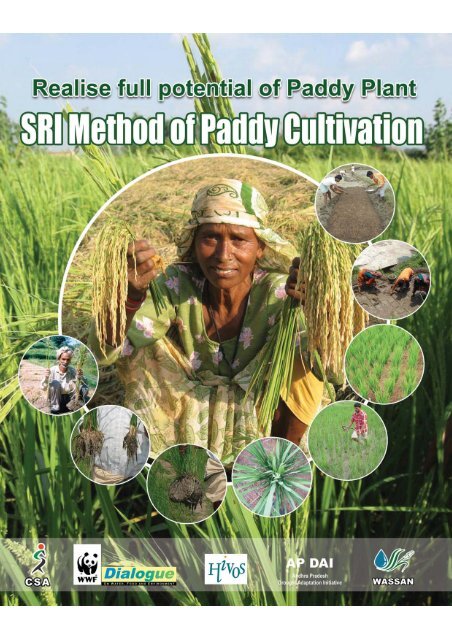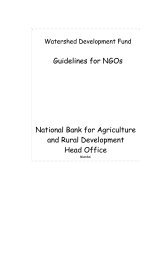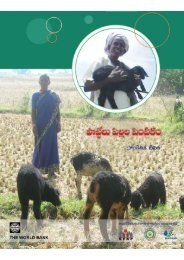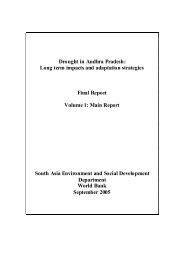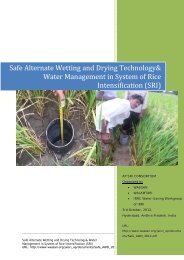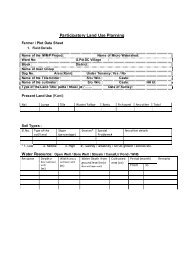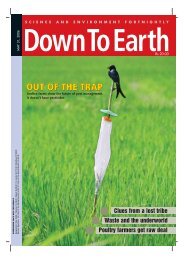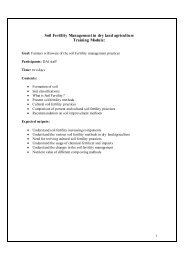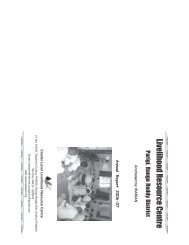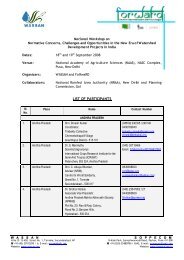SRI Method of Paddy Cultivation - WASSAN
SRI Method of Paddy Cultivation - WASSAN
SRI Method of Paddy Cultivation - WASSAN
You also want an ePaper? Increase the reach of your titles
YUMPU automatically turns print PDFs into web optimized ePapers that Google loves.
2<br />
To achieve higher productivity in paddy:<br />
❈ A plant should have more number <strong>of</strong> tillers<br />
❈ The number <strong>of</strong> effective tillers should be higher<br />
❈ The number <strong>of</strong> grains in a panicle should be higher<br />
❈ The grain weight should be more<br />
<strong>SRI</strong> <strong>Method</strong> <strong>of</strong> <strong>Paddy</strong> cultivation helps in achieving the above.<br />
The objective <strong>of</strong> this booklet is to give the principles and opportunities behind the<br />
above aspects.<br />
<strong>SRI</strong> <strong>Method</strong> <strong>of</strong> <strong>Paddy</strong> <strong>Cultivation</strong><br />
First Print: November, 2006<br />
No. <strong>of</strong> Copies: ?<br />
Published by:<br />
<strong>WASSAN</strong><br />
(Watershed Support Services and Activities Network)<br />
12-13-452, St. No.1, Tarnaka, Secunderabad – 500 017<br />
Ph.: 040-27015295/ 27015296, 65284580<br />
E.mail: wassan@eth.net; website: www.wassan.org<br />
For Hindi or Oriya Editions<br />
(Your Organisation Address)<br />
Photo and Content courtesy:<br />
Kishan Rao, sukshethram, Hyderabad<br />
WWF, ICRISAT, Hyderabad<br />
CRISP, Hyderabad<br />
Jagadeeshwara Raju, ADA, Akiveedu<br />
Acharya N G Ranga Agriculture University, Hyderabad<br />
Sitaramaswamy, Hyderabad<br />
People’s Science Institute, Dehradun<br />
<strong>SRI</strong> <strong>Method</strong> <strong>of</strong> <strong>Paddy</strong> <strong>Cultivation</strong><br />
Financial Support:
<strong>SRI</strong> <strong>Method</strong> <strong>of</strong> <strong>Paddy</strong> <strong>Cultivation</strong> 3
4<br />
<strong>SRI</strong> is an acronym for System <strong>of</strong> Rice Intensification. This improved<br />
method <strong>of</strong> rice cultivation was developed in 1983 in Madagascar<br />
and has now spread to many parts <strong>of</strong> the world.<br />
<strong>SRI</strong> is neither a new<br />
variety nor a hybrid…<br />
It is only a method <strong>of</strong><br />
cultivating paddy.<br />
Any paddy variety can be<br />
cultivated by this<br />
method.<br />
<strong>SRI</strong> practices collated in this<br />
book are based on farmers’<br />
practices and their<br />
experiences. As innovation<br />
and local adaptation are the<br />
hallmarks <strong>of</strong> <strong>SRI</strong>, farmers<br />
should further refine these<br />
practices according to their<br />
local situation.<br />
<strong>SRI</strong> <strong>Method</strong> <strong>of</strong> <strong>Paddy</strong> <strong>Cultivation</strong><br />
1. <strong>SRI</strong> <strong>Method</strong> means...<br />
There is a notion that what has been done in research plots<br />
and by scientists is modern and desirable. However, it is<br />
farmers who played a key role in designing and developing<br />
<strong>SRI</strong> method <strong>of</strong> cultivation practices. Thus every farmer has to<br />
be a scientist and an experimenter. Farmer should not blindly<br />
follow what is suggested by others. One has to understand<br />
the principles behind and decide upon what to do based on<br />
local situation and available resources. This is the key aspect<br />
in <strong>SRI</strong> method <strong>of</strong> cultivation.<br />
For the paddy plant to achieve its full potential<br />
and give high yield:<br />
❋ A plant should have more number <strong>of</strong> tillers<br />
❋ The number <strong>of</strong> effective tillers should be higher<br />
❋ Panicle length and number <strong>of</strong> grains per panicle should<br />
be higher<br />
❋ The grain weight should be more<br />
❋ The roots should have extensive and healthy growth<br />
Let us explore different methods in achieving the above<br />
objectives. Along with various opportunities let us explore the<br />
limitations, problems and challenges in each <strong>of</strong> the aspects.<br />
Let farmer’s fields be experimenting grounds.
Attributes in <strong>SRI</strong> method that help in achieving higher productivity<br />
Wide planting:<br />
With wide spacing each plant gets more space, air and sunlight. As a<br />
result each plant gives more tillers. The roots would grow healthily and<br />
extensively and take in more nutrients. As the plant is strong and healthy<br />
the number <strong>of</strong> tillers would be more. The panicle length would be more.<br />
The panicle has more number <strong>of</strong> grains and the grain weight would also<br />
be more.<br />
Less seed:<br />
As wide spacing is adopted the seed required would be less. This results in<br />
the advantages mentioned above. Further it is easy to use and produce quality<br />
seed.<br />
Transplanting young seedling:<br />
The seedling should be transplanted when it is in 2 leaf stage. When the<br />
seedling is transplanted carefully in this stage it grows healthily and<br />
generates more number <strong>of</strong> tillers. It can achieve the potential <strong>of</strong> giving<br />
higher yield.<br />
Less water:<br />
When the water is stagnating in the field the roots die due to lack <strong>of</strong> air. The<br />
dead roots are brown/ rusty in colour. The soil should have soil particles, air<br />
and moisture in equal proportions. The paddy plant can survive even when<br />
there is standing water. But, for a healthy paddy plant water should not be in<br />
stagnated situation in the field. When irrigation is provided intermittently the<br />
roots are aerated and grow healthily.<br />
Turning back the weeds into the soil:<br />
Instead <strong>of</strong> weeding and throwing the weeds outside the plot there are<br />
several advantages <strong>of</strong> turning the weeds into the soil by using a ‘weeder’.<br />
This results in two advantages: firstly, the soil gets aerated and secondly,<br />
the weeds get decomposed in the soil and turn into organic matter. Due<br />
to this the roots and the plant grow healthily and higher yields can be<br />
achieved.<br />
Use <strong>of</strong> organic manures:<br />
Organic matter is the food for life forms teeming in the soil. When organic<br />
matter is added the microorganisms in the soil multiply manifold. The<br />
microorganisms bring nutrients into available form and are made available to<br />
them as and when they are needed.<br />
<strong>SRI</strong> <strong>Method</strong> <strong>of</strong> <strong>Paddy</strong> <strong>Cultivation</strong><br />
5
6<br />
Farmers who want to<br />
cultivate paddy by <strong>SRI</strong><br />
method:<br />
❋ Should level their plots<br />
❋ Should plan for drainage<br />
channels, if needed<br />
❋ Should make plots <strong>of</strong> small<br />
size<br />
Problems and Challenges<br />
Wherever paddy is cultivated<br />
under canals nurseries are<br />
raised in advance and farmers<br />
would be ready for<br />
transplantation when irrigated<br />
water is released into the<br />
canals. Under rainfed areas the<br />
farmers start transplantation as<br />
soon as the tank gets filled.<br />
Several experiments should be<br />
done to integrate green manure<br />
crop into the cropping pattern.<br />
<strong>Method</strong>s <strong>of</strong> cultivating green<br />
manure with less water and<br />
quick ways <strong>of</strong> decomposing<br />
should be explored.<br />
Silt Application<br />
<strong>SRI</strong> <strong>Method</strong> <strong>of</strong> <strong>Paddy</strong> <strong>Cultivation</strong><br />
2. Selection <strong>of</strong> Suitable Soils<br />
What are suitable soils:<br />
❋ Soils that are not affected by salinity<br />
❋ Level fields that are convenient to irrigate and drain<br />
❋ Fertile soils<br />
Farmers who want to follow <strong>SRI</strong> method should first get the soil<br />
tested and know all the details.<br />
2.1 Saline Soils<br />
Saline or alkali soils are not suitable for <strong>SRI</strong> cultivation. In saline<br />
soils paddy yields would be satisfactory when it is cultivated under<br />
flooded conditions. But in <strong>SRI</strong> method the field is drained<br />
intermittently. When soil is allowed to dry the salts accumulate in<br />
the surface resulting in damage to the rice plant.<br />
2.2 Level plots<br />
Land selected for <strong>SRI</strong> method should be level. When the plot is<br />
irrigated the water should spread uniformly across the field.<br />
Similarly, whenever needed there should be facility to drain the<br />
excess water.<br />
2.3 Fertile soils<br />
<strong>SRI</strong> method <strong>of</strong> cultivation responds better to organic manures<br />
rather than chemical fertilisers. The organic matter is the food for<br />
the soil microorganisms. When the soil is alive with<br />
microorganisms then the nutrients needed for the plant would be<br />
in readily available form. This means that rather than the nutrients<br />
in the soil the form in which they are present is more important.<br />
When soil is rich with microorganisms then the plant grows<br />
healthily, develops resistance to pests and diseases and yields<br />
higher. Thus methods <strong>of</strong> improving the soil fertility should be taken<br />
up right from the beginning. At least two methods from the following<br />
should be practiced every year.
Application <strong>of</strong> tank silt<br />
Tank silt should be applied at the rate <strong>of</strong> 15-20 cartloads per acre<br />
(40-50 tons/ha). This improves the moisture holding capacity <strong>of</strong><br />
the soil, which in turn results in better yields.<br />
Farm Yard manure (FYM)<br />
Application <strong>of</strong> well decomposed FYM/ compost is a must for <strong>SRI</strong><br />
method <strong>of</strong> cultivation. At least 15 cartloads or 3 tractor loads<br />
(6tons) <strong>of</strong> FYM/ compost should be applied per every acre. FYM<br />
should be <strong>of</strong> very good quality. Of late preparation and use <strong>of</strong><br />
vermicompost is gaining popularity.<br />
Green manure crop<br />
Green manure crops helps in significantly improving the soil<br />
fertility. Green manure crops I cultivated upto 50% flowering stage<br />
and ploughed back into the soil. Sunnhemp and sesbania are<br />
the common green manure crops. Green manure crop is cultivated<br />
for about 45 days and it takes another 10 days to get decomposed<br />
into organic matter. Sow the paddy nursery on the day <strong>of</strong><br />
incorporating the green manure crop into the soil. By the time the<br />
green manure crop gets decomposed the nursery would be ready<br />
for transplantation. Ensuring water for raising and decomposing<br />
and the time period are essential for the green manure crop.<br />
Livestock Penning<br />
This is a traditional practice in which cattle, goats and sheep are<br />
flocked in the field during the night. The soil gets enriched with<br />
the dung and urine <strong>of</strong> the animals.<br />
Sheep penning Green menure FYM heap<br />
In the fields that are leveled newly<br />
the top soil gets disturbed. As a<br />
result during the first year no crop<br />
would be successful. It is better to<br />
avoid <strong>SRI</strong> method <strong>of</strong> cultivation in<br />
such fields.<br />
Quality check for FYM heap<br />
❋ There is complete breakdown <strong>of</strong> the<br />
physical structure <strong>of</strong> all the raw<br />
materials used and they can no longer<br />
be identified<br />
❋ The heap is in dark brown to black colour<br />
❋ There is sweet and earthy smell<br />
❋ The mass is spongy and moisture<br />
retaining and<br />
❋ Presence <strong>of</strong> micro organisms visible to<br />
normal eye<br />
Dabholkar method <strong>of</strong> green<br />
manuring<br />
This method is gaining popularity in the<br />
recent years. Normally a single,<br />
preferably leguminous crops is<br />
cultivated for green manure. However,<br />
in Dabholkar method at least 4 species<br />
from each <strong>of</strong> the categories mentioned<br />
below are selected and a total <strong>of</strong> 25 kg<br />
is seed is used per acre. From the first<br />
4 categories take seed <strong>of</strong> 6 kg each and<br />
from the fifth category take 1 kg seed.<br />
1. Cereals (Jowar, Bajra, Foxtail millet,<br />
Finger millet, Samalu)<br />
2. Pulses (Blackgram, greengram,<br />
Bengalgram, Beans)<br />
3. Oilseeds (Sesame, Groundnut,<br />
Sunflower, Castor)<br />
4. Green manures (Sesbania,<br />
Sunnhemp, horsegram, Pillipesara)<br />
5. spices (Mustard, Coriander, Methi,<br />
Ajwain)<br />
<strong>SRI</strong> <strong>Method</strong> <strong>of</strong> <strong>Paddy</strong> <strong>Cultivation</strong><br />
7
8<br />
Transporting the uprooted<br />
seedlings to the main field<br />
Transporting the young seedlings<br />
to the main field is one <strong>of</strong> the<br />
problems. The means to<br />
overcome this problem are:<br />
❋ Take up nursery raising near<br />
to the main field.<br />
❋ For every acre have one<br />
nursery <strong>of</strong> 400 sq.ft. either in<br />
the centre or on one side <strong>of</strong><br />
the field<br />
❋ Raise nursery in banana trunk<br />
leaf or plastic trays<br />
❋ Raise nursery in ‘mat’ method<br />
<strong>SRI</strong> <strong>Method</strong> <strong>of</strong> <strong>Paddy</strong> <strong>Cultivation</strong><br />
3. Raising Nursery<br />
In <strong>SRI</strong> method, utmost care should be taken in the preparation <strong>of</strong><br />
nursery bed, as 8-12 days old seedlings are transplanted.<br />
3.1 Bed Preparation<br />
The bed should be 4 feet wide. The length can vary depending<br />
on the need and space available. Two kgs seed would be needed<br />
for transplanting in one acre. For raising this, a nursery bed <strong>of</strong><br />
400 sq.ft. would be required. Depending upon the convenience<br />
a single bed or several smaller beds (say, 4 beds <strong>of</strong> 4 x 25 feet)<br />
can be prepared. As the roots <strong>of</strong> 8-12 day old seedling would<br />
grow upto 30 inches, it is necessary to prepare raised beds <strong>of</strong><br />
5-6 inches.<br />
Nursery bed is prepared in this manner:<br />
1 st layer: 1 inch thick well decomposed FYM<br />
2 nd layer: 1 ½ inch soil<br />
3 rd layer: 1 inch thick well decomposed FYM<br />
4 th layer: 2 ½ inch soil<br />
All these layers should be thoroughly mixed.<br />
Make a channel around the nursery bed. To prevent the wet soil<br />
dropping down the bed should be made secure on all sides with<br />
wooden planks, bamboos or any other suitable material.<br />
Farm yard manure helps in easy presentation <strong>of</strong> roots. The<br />
plants that are grown in well decomposed manure gain<br />
resistance to diseases. Later, in the main field also the plant<br />
grows healthily without any diseases.<br />
Benefits with less seed<br />
❋ Cost is less; if needed, even foundation seed can be used<br />
❋ Quality seeds can be carefully selected/ collected<br />
❋ After the soaking the grains in water, the ill filled grains that float<br />
can be removed, or even hand picking can be done<br />
❋ Seed production can be taken up with even less quantity <strong>of</strong><br />
seed, if <strong>SRI</strong> method is followed again, with less quantity <strong>of</strong> seed<br />
large areas can be covered within one year itself
3.2 Seed soaking, broadcasting<br />
Using pre-soaked and germinated seeds is one <strong>of</strong> the methods<br />
in raising nursery. There are other methods <strong>of</strong> raising nursery also.<br />
Here let us learn about the process <strong>of</strong> pre-soaking and<br />
germinating seeds before sowing them in the nursery.<br />
Germinating the seeds: Soak the paddy seed for 12 hours.<br />
Transfer the soaked seed into a gunny bag or make a heap and<br />
cover it with gunny clothe. Leave it for 24 hours. At this time the<br />
seed germinates. You can observe the white root or radicle<br />
emerges from the seed. This seed is used for sowing on the<br />
nursery bed. If sowing is delayed, the roots grow and get matter<br />
together making it difficult to sow the seeds with wider spacing.<br />
Broadcasting the seed: To ensure uniform broadcasting, make<br />
the seed into 4 equal parts. Broadcast each part separately one<br />
after the other. Two seeds should be separated by a distance <strong>of</strong><br />
length <strong>of</strong> one seed. It is better to broadcast the seeds in the<br />
evenings.<br />
Covering the seed: Cover the seed with a thin layer <strong>of</strong> well<br />
decomposed FYM or dry soil. Even paddy straw can be used for<br />
this purpose. The seed is protected from direct sun and rain by<br />
this layer. It also protects from being eaten away by birds and<br />
ants. When straw is used as a layer it should be removed after<br />
the appearance <strong>of</strong> the shoots.<br />
Watering the beds: Depending upon the need, watered the bed<br />
daily in the morning and evening. The water should be gently<br />
sprinkled over the bed. One can use the garden rose can for this<br />
purpose. When pots are used for watering, use one hand to break<br />
the force <strong>of</strong> the water. The nursery can be watered by letting in<br />
water into the canal surrounding the nursery bed.<br />
Community Nurseries:<br />
Having seedlings ready for<br />
transplantation by the time rains<br />
are received is an important issue.<br />
As less seed is needed and<br />
young seedlings <strong>of</strong> 8-12 days are<br />
planted one can plan for<br />
community nurseries. Nursery<br />
beds can be sown can be sown<br />
in a staggered manner with 2-3<br />
days interval. This ensures that<br />
seedlings are available at different<br />
times. This might result in certain<br />
wastage <strong>of</strong> seedlings but the<br />
objective <strong>of</strong> timely transplantation<br />
would be ensured.<br />
<strong>SRI</strong> <strong>Method</strong> <strong>of</strong> <strong>Paddy</strong> <strong>Cultivation</strong><br />
Seedling<br />
9
10 <strong>SRI</strong> <strong>Method</strong> <strong>of</strong> <strong>Paddy</strong> <strong>Cultivation</strong><br />
[<br />
[<br />
Raising Nursery<br />
[<br />
Nursery raising by ‘mat’ method<br />
The nursery is raised on polythene sheet or empty fertiliser bags. A<br />
steel or wooden frame with four compartments is used. The<br />
dimensions <strong>of</strong> the frame are 1 x 0.5 metres. Each compartment<br />
would measure 0.125 sq.metres. The nursery bed <strong>of</strong> 4 cm thickness<br />
is prepared using well decomposed<br />
FYM and soil. Broadcast the seed<br />
on the bed and cover it with mud. After watering the nursery bed the<br />
frame can be removed and reused. For the first 5 days the beds are<br />
watered using rose can 2-3 times, every day depending on the need.<br />
Later the nursery can be watered by letting in water into the canal around<br />
the nursery bed. The nursery is uprooted in chunks and transported to<br />
the main field.<br />
[
Phyllocrons and <strong>Paddy</strong> yields<br />
In <strong>SRI</strong> method the first 4-5 weeks after transplantation the field would<br />
look terrible. The plants are small and wide apart. As there is no<br />
standing water the land looks dried up. However, in this stage the<br />
plant is preparing itself to tiller. The tillering starts in the second month<br />
and is in exponential stage in the third month. To understand this<br />
one has to know about ‘phyllocron’ in paddy.<br />
‘Phyllocron’ is the time taken to form a new tiller with a leaf and root.<br />
This is mainly influenced by the temperature followed by day length,<br />
humidity, soil moisture, soil texture, availability <strong>of</strong> nutrients, aeration<br />
and sunlight. If all the conditions are favourable one phyllocron is<br />
completed in 5 days. Or else it might take 6-7 days or even more. It<br />
is ideal that the rice plant complete 12 phyllocrons by the time<br />
vegetative phase is over and panicle initiation has taken place. A<br />
new tiller after completing two phyllocrons also starts tillering. This<br />
means that the number <strong>of</strong> new tillers increases geometrically.<br />
If germination is considered as the first phyllocron stage, then it is<br />
ideal to transplant it in 2nd or 3rd phyllocron stage. By this the<br />
phenomenal growth that would take place from the 4th phyllocron<br />
would not get disturbed. The phylocron stage and number <strong>of</strong> tillers<br />
would be as follows. This is what happens in <strong>SRI</strong> method.<br />
Phyllocron stage<br />
1 2 3 4 5 6 7 8 9 10 11 12<br />
New tillers 1 0 0 1 1 2 3 5 8 12 20 31<br />
Total tillers 1 1 1 2 3 5 8 13 21 33 53 84<br />
<strong>SRI</strong> <strong>Method</strong> <strong>of</strong> <strong>Paddy</strong> <strong>Cultivation</strong><br />
11
Marking in the field<br />
Marker<br />
What spacing to be followed<br />
We have seen that with wider<br />
spacing the plant grows healthily<br />
and yields better. It was also<br />
recommended that 25 x 25 cm.<br />
spacing should be followed in <strong>SRI</strong><br />
method. However, there are<br />
several farmers who have<br />
experimented with 50 x 50 cm.<br />
and 1 x 1 metre spacing and<br />
obtained good yields.<br />
12 <strong>SRI</strong> <strong>Method</strong> <strong>of</strong> <strong>Paddy</strong> <strong>Cultivation</strong><br />
4. Preparation <strong>of</strong> Main Field<br />
Preparation <strong>of</strong> the main field in <strong>SRI</strong> is the same as in<br />
conventional method. However it is ideal that the field is dry<br />
ploughed and puddling by tractor is avoided. Particularly in black<br />
soils the field should be ploughed and kept ready during summer<br />
itself. The field should be watered and transplanted. This way it<br />
would be easy to operate the weeder later. As puddling by tractor<br />
is not done the weeder would not get stuck and less energy would<br />
be sufficient to run the weeder.<br />
The field should be level and there should be no standing water<br />
while transplanting.<br />
If the plots are small and leveled water management becomes<br />
easy. If needed, canals should be prepared for irrigating and<br />
draining the <strong>SRI</strong> plots.<br />
4.1 Wide spacing<br />
Wide spacing is important in <strong>SRI</strong> method. The row to row distance<br />
and within a row plant to plant distance should be 10 x 10 inches<br />
(25 x 25 cms). With this spacing there would be 16 plant per<br />
square metre in <strong>SRI</strong> method. If there is any doubt regarding the<br />
survival <strong>of</strong> plant then two plants can be transplanted per hill. In the<br />
conventional method 33-40 hills are transplanted per square<br />
metre with 4-5 plants per hill.<br />
4.2 Use <strong>of</strong> Marker<br />
There are several ways by which to transplant at 10 x 10 inches<br />
spacing. Take a rope and tie a knot or a stick at every 10 inches.<br />
Using this rope as guide, transplant one row after the other.<br />
However, markers are available to help transplanting at 10 x 10<br />
inches spacing. There are markers made out <strong>of</strong> wood as well as<br />
iron. There are bar markers which have to be drawn either way to<br />
form a grid and roller markers which would form grids at one go.
The paddy seedling has to be transplanted where the vertical<br />
and horizontal lines meet. The roller marker gives 8 grids at a<br />
time.<br />
For the rows to be straight it is ideal that a rope is tied along the<br />
length <strong>of</strong> the field and the marker is drawn along the rope. After<br />
pulling the marker once, i.e. for every 2 metres it is ideal to leave<br />
12-13 inches path. Tie a rope as guide and draw the marker again<br />
along the rope.<br />
The roller marker should be pulled at a certain speed.<br />
Otherwise the roller wouldn’t turn and gets dragged on the field.<br />
4.3 Leaving pathways<br />
Farmers are advised to leave paths for every 2 metres. Farmers<br />
have adopted this practice. However, the farmers first transplant<br />
the entire field. Paths are made later by tying a rope at ever 2<br />
metres; the plants on both the sides are uprooted and<br />
retransplanted aaway from the path. In <strong>SRI</strong> method when roller<br />
marker is used after pulling the marker once lengthwise across<br />
the field, i.e. after every 8 rows, the marker should be pulled after<br />
leaving a gap <strong>of</strong> 12-13 inches. The path in between every 8 rows<br />
is sued for transplanting also.<br />
These paths result in good aeration <strong>of</strong> the paddy fields. As a<br />
result the pest and disease intensity gets reduced. Normally we<br />
observe that the plants along the bunds and paths growing<br />
healthily. In paddy fields the plants along these pathways also<br />
grow healthily. These paths are also useful for observation and<br />
interculture operations. However, as wide spacing is used in <strong>SRI</strong><br />
method some farmers are avoiding these paths.<br />
For smooth transplantation, field operations like cleaning <strong>of</strong><br />
bunds, leveling and marking should be completed a day before<br />
transplantation.<br />
Different types <strong>of</strong> markers<br />
Farmers have prepared different types<br />
<strong>of</strong> markers using rope, wood and iron.<br />
There are markers with 4 rows and<br />
super markers with 16 rows.<br />
In Andhra Pradesh during Sankranti<br />
time rangolis are drawn using a small<br />
drum (approx. ½ inch wide and 4<br />
inches long) with holes. Based on this<br />
the farmers have designed the roller<br />
marker. In the roller marker the<br />
horizontal and vertical lines are formed<br />
by pulling it, thus forming grids.<br />
Koundinya marker<br />
Wooden marker<br />
Problems with markers<br />
❋ In roller marker, instead <strong>of</strong> the<br />
roller rotating it gets dragged on<br />
the field<br />
❋ Whenever there is an obstruction<br />
like stone, stubble or stem the<br />
roller marker jumps and the grids<br />
are not formed<br />
❋ After cultivating and incorporating<br />
the green manure crop it is difficult<br />
to form lines with a marker<br />
<strong>SRI</strong> <strong>Method</strong> <strong>of</strong> <strong>Paddy</strong> <strong>Cultivation</strong><br />
Roller marker<br />
13
Transplanting at the marker points<br />
Using trays to lift the seedling<br />
14 <strong>SRI</strong> <strong>Method</strong> <strong>of</strong> <strong>Paddy</strong> <strong>Cultivation</strong><br />
5. Transplantation<br />
Young, 8-12 day seedlings are transplanted in <strong>SRI</strong> method. The<br />
nursery should be raised with utmost care. Similarly, care should<br />
be taken to transplant the seedling without experiencing any<br />
‘shock’. The seedling should not be damaged either during or<br />
uprooting or transplanting in the main field. The family members<br />
and farm labourers engaged in this activity should be educated<br />
in this regard.<br />
In the conventional method, the practice is to pull the seedlings<br />
by holding the plant. But in <strong>SRI</strong> method the plants would be very<br />
small. So a metal sheet is pushed 4-5 inches below the nursery<br />
and lifted on to the plate. This means that the seedlings along<br />
with the soil are taken on to the sheet. This can be transported to<br />
the main field on the metal sheet itself or transferred into a wicker<br />
basket or gamela. After uprooting the seedling transplantation<br />
should be completed as soon as possible, preferably within half<br />
an hour. This minimizes the trauma to the seedling.<br />
When the nursery is raised in plastic trays or banana trunk<br />
leaves, they can be transported along with them.<br />
When the nursery is raised in ‘mat’ method, it would be easier<br />
to lift the nursery in patches and transport it to the main field.<br />
It is important to see that peaceful atmosphere prevails during<br />
transplantation. Transplantation should be done with utmost care<br />
and concentration. Transplanting wouldn’t be proper amidst<br />
shouts, quarrels and tension.<br />
5.1 <strong>Method</strong> <strong>of</strong> Transplanting<br />
In the conventional method, seedlings are transplanted by<br />
thrusting them into the soil using the middle and the pointing<br />
fingers. With this the root takes a ‘U’ turn. This means that the
oots are looking upwards. Thus the root takes time to turn<br />
downward again and get established in the soil.<br />
However, in <strong>SRI</strong> method the seedlings are transplanted shallow<br />
with the roots forming a ‘L’ shape. Start at 1 inch above the<br />
intersection <strong>of</strong> the horizontal and vertical lines and gently pull down<br />
using the pointing finger. The seedling is taken along with the soil<br />
using the thumb and pointing finger. As a result the seedling<br />
establishes quickly and grows healthily. The field should be lightly<br />
irrigated either on the same day or the day after transplantation.<br />
Initially, <strong>SRI</strong> method requires 10-15 persons to transplant one acre.<br />
Once the farmers/ labourers gain experience it can be completed<br />
with fewer persons.<br />
There is an advantage in<br />
transplanting the seedling as<br />
soon as possible after it is<br />
uprooted from the nursery.<br />
This helps the plant to put up<br />
extensive and healthy root<br />
system, resulting in the plant<br />
realizing its full yield<br />
potential.<br />
Transplanted field<br />
Direct sowing<br />
In certain regions there is the<br />
practice <strong>of</strong> direct sowing <strong>of</strong><br />
paddy. The same system can<br />
be adopted in <strong>SRI</strong> method also.<br />
Direct sowing can be done at<br />
the spacing followed in <strong>SRI</strong><br />
method.<br />
Some farmers are<br />
experimenting with forming<br />
paddy seed pellets with soil for<br />
directly sowing them. To reduce<br />
drudgery/ labour experiments<br />
are being conducted to drop the<br />
seeds using a hollow iron rod/<br />
tube.<br />
The field should be prepared as<br />
in transplanting and marker<br />
should be used to form the<br />
grids. 3 days prior to this the<br />
required paddy seed should be<br />
soaked and kept for germination<br />
as in nursery system. 1 to 3<br />
germinated seeds should be<br />
dropped at the grid junctions.<br />
Another person should cover<br />
the seed using organic manure.<br />
<strong>SRI</strong> <strong>Method</strong> <strong>of</strong> <strong>Paddy</strong> <strong>Cultivation</strong><br />
15
Mandava weeder<br />
In Gujarat, there is an experience <strong>of</strong><br />
managing weeds by cultivating<br />
Berseem as an inter crop along<br />
with <strong>Paddy</strong>. Similarly suitable inter<br />
crops can be chosen as per the local<br />
conditions for effective weed<br />
management.<br />
16 <strong>SRI</strong> <strong>Method</strong> <strong>of</strong> <strong>Paddy</strong> <strong>Cultivation</strong><br />
6. Weed Management<br />
As there is no standing water in <strong>SRI</strong> method, weeds would be<br />
more. Instead <strong>of</strong> weeding manually and throwing the weeds<br />
outside the plot there are several advantages <strong>of</strong> turning the<br />
weeds into the soil by using an implement called ‘weeder'.<br />
Weeds are useful for the soil as organic manure. So the weeds<br />
should be allowed to grow and then turned into the soil<br />
intermittently. Use the weeder on the 10th and 20th day after<br />
transplantation. The weeding problem is addressed to a large<br />
extent with this effort. If the weeder is used on 30th and 40th day<br />
after transplantation, there will be more aeration to the plant roots<br />
resulting in their healthy growth.As the plant is strong and healthy,<br />
the number <strong>of</strong> tillers would be more.<br />
Weeder should be moved front and back between every two<br />
rows. Start using the weeder, when the weeds are small, i.e; on<br />
10th day after transplantation. If the rice plant is tender or weeds<br />
are less, weeding should be done manually.<br />
By using the weeder, the first advantage is the control <strong>of</strong> weeds<br />
and also adding organic matter to the soil. This gives the benefit <strong>of</strong><br />
cultivating a green manure crop.Further, the soil gets aerated and<br />
the roots are exposed to air This results in pr<strong>of</strong>use growth <strong>of</strong> diverse<br />
soil micro organisms which make nutrients available to the plant.<br />
Under no circumstances, chemical herbicides should be used in<br />
<strong>SRI</strong> method.<br />
While weeding with the weeder in one acre <strong>of</strong> crop, a person has<br />
to traverse a distance <strong>of</strong> 16 kilo metres.So a weeder should be<br />
efficient in its function and easy to use so as to reduce the drudgery<br />
on labour.<br />
Equipment Bank<br />
To reduce the problems <strong>of</strong> farmers, either in terms <strong>of</strong> cost or<br />
availability, equipment bank is one way out. A village or a group <strong>of</strong><br />
farmers should have certain number <strong>of</strong> weeders and markers<br />
which in turn can be used by the members as per their need.
Important principles <strong>of</strong> Weeders<br />
❋ The space between two rice plants is wider after transplantation, which gets reduced with progressive<br />
tillering. Accordingly, the width <strong>of</strong> the weeder should be adjustable.<br />
❋ There should be arrangement to clean the mud that gets stuck to<br />
the teeth.<br />
❋ It should be <strong>of</strong> low cost and easy to be prepared locally.<br />
❋ It should be light and durable.<br />
❋ The design should be in such a way that it reduces the<br />
walking distance.<br />
❋ If the weeder is mechanized, the drudgery would be less.<br />
Kollur Weeder<br />
Japan Weeder Raichur Weeder<br />
Mandava Weeder<br />
Cono Weeder<br />
Single Drum Weeder Mechanized Weeder<br />
Star Weeder<br />
The weeders that are available in the market are a bit costly. There are some<br />
problems with the design also. When these are being used in heavy soils, there are<br />
several problems. Different weeders were studied and by combining the advantages<br />
<strong>of</strong> each one, a new 'mandava ' weeder has been designed The weeder got its name<br />
after 'Chinna Mandava", a village in Khammam district in Andhra Pradesh, where it<br />
has been tested and fine tuned.<br />
Low cost : The weeder can be manufactured within a cost <strong>of</strong> Rs 550/-<br />
Convinient Design : It is <strong>of</strong> less weight and can be used in all types <strong>of</strong> soils.<br />
Technicallly Efficient : It incorporates the weeds deep into soil.<br />
Opearational Flexibility : It is easy to operate without drudgery. It has fleible<br />
movement.<br />
<strong>SRI</strong> <strong>Method</strong> <strong>of</strong> <strong>Paddy</strong> <strong>Cultivation</strong><br />
17
Rice plant can grow in water but<br />
it is not necessary that the <strong>Paddy</strong><br />
field be inundated with water<br />
The <strong>SRI</strong> plots should have secured<br />
water resources so as to irrigate the<br />
field as and when required. When<br />
paddy is cultivated under borewells,<br />
the electricity supply is not ensured.<br />
Further there is a problem <strong>of</strong> the<br />
motor getting damaged. Hence the<br />
farmers retort to flood the fields from<br />
the begining.A suitable solution<br />
should be identified for such<br />
situations.<br />
Until the farmers gain the confidance<br />
in <strong>SRI</strong> method, few alternative<br />
methods can be followed. For<br />
example, instead <strong>of</strong> waiting until the<br />
field develops hairline cracks before<br />
irrigating, start with lesser intervels<br />
and slowly increase the gap between<br />
the two irrigations.<br />
18 <strong>SRI</strong> <strong>Method</strong> <strong>of</strong> <strong>Paddy</strong> <strong>Cultivation</strong><br />
7. Water Management<br />
The farmers grow paddy under flooded conditions so as to<br />
control the weeds. In canal command areas as well as borewell<br />
irrigated areas, more water then is required is being used for<br />
paddy. What happens when the soil is flooded with water?.... The<br />
roots die due to lack <strong>of</strong> aeration.<br />
That is why the fields are not flooded under <strong>SRI</strong> method. Irrigation<br />
water is provided so as to wet the soil. The field should be irrigated<br />
again when the soil develops hairline cracks. Depending upon<br />
the soil and the environment conditions, the frequency <strong>of</strong> irrigation<br />
should be decided.<br />
As the soil is not flooded, the roots <strong>of</strong> the paddy plant grow healthiliy,<br />
deeply in all directions. The root growth is extensive also due to<br />
the wide spacing. As the field is intermittently irrigated and dried,<br />
the micro organisms well which make nutrients available to the<br />
plant.<br />
A day before using the weeder, the field should be lightly irrigated.<br />
After the weeding, under no circumstances the water should be<br />
drained out <strong>of</strong> the field. If this water is drained, all the nutrients<br />
would be lost from the field.<br />
After the panicle initiation stage until maturity, one inch <strong>of</strong> water<br />
should be maintained in the field. The water can be removed after<br />
70% <strong>of</strong> the grains get hardened.<br />
If the plot is uneven, water would be stagnating at low points and<br />
field dried up at high points. If irrigation water is to be used<br />
efficiently then the plots should be small and levelled.<br />
Instead <strong>of</strong> letting in the water until it reaches the end <strong>of</strong> the field, it<br />
may be stopped (depending upon the local conditions) after 3/4<br />
<strong>of</strong> the field is irrigated. The water automatically spreads to the<br />
entire field. If any excess water is to be drained out <strong>of</strong> the field, it<br />
may be used to raise vegetables in a small plot at the end <strong>of</strong> the<br />
field or plants on the bunds.
8. Pest & Disease Management<br />
The uniqueness <strong>of</strong> <strong>SRI</strong> method lies in not using the chemical<br />
pesticides and herbicides. Wider spacing and use <strong>of</strong> organic<br />
manures results in healthy growth <strong>of</strong> the plants and incidence <strong>of</strong> the<br />
pests and diseases is naturally low. The pests can be easily managed<br />
by using some organic concoctions either as a peventive measure<br />
or as and when needed. Amrit Jalam is one such concoction.<br />
Preparation <strong>of</strong> Amrit Jalam<br />
Required materials:<br />
Cow urine - one Litre<br />
Cow dund - One Kilo<br />
Jaggery (organic) - 250 grams<br />
Water (chlorine free) - 10 litres<br />
Preparation and Use:<br />
Mix all the above materials in a plastic container or an earthen pot. Let them ferment for 24<br />
hours. Dilute this with water in the ratio <strong>of</strong> 1:10. Filter the solution using a fine cloth. This can be<br />
used for spraying.<br />
Amrit Jalam can be stored for a period <strong>of</strong> 30 days. However it has to be stirred daily. When urea<br />
is used, the plants grow succulently and or easily susceptible to pests and diseases. When<br />
Amrit Jalam is sprayed, it not only gives nitrogen to the plants but also repels harmful insects<br />
and micro organisms.<br />
Harvesting<br />
The grain matures even while the crop is green in colour.<br />
Hence farmers should be ready to undertake timely harvesting.<br />
<strong>SRI</strong> <strong>Method</strong> <strong>of</strong> <strong>Paddy</strong> <strong>Cultivation</strong><br />
19
Advantages <strong>of</strong> <strong>SRI</strong><br />
❖ Saving on seed cost as the seed<br />
requirement is less<br />
❖ Saving on water as Irrigated - Dry<br />
method is followed<br />
❖ Cost <strong>of</strong> external inputs gets reduced<br />
as chemical fertilizers and<br />
pesticides are not used<br />
❖ Incidence <strong>of</strong> pests and diseases<br />
is low as the soil is allowed to dry<br />
intermittently.<br />
❖ More healthy and tasty rice as a result <strong>of</strong> organic farming practices.<br />
❖ Higher yields due to pr<strong>of</strong>use tillering, increased panicle length and grain weight<br />
❖ Seed multiplication with less quantity <strong>of</strong> parent seed.<br />
❖ Farmers can produce their own quality seed.<br />
20 <strong>SRI</strong> <strong>Method</strong> <strong>of</strong> <strong>Paddy</strong> <strong>Cultivation</strong><br />
'<strong>SRI</strong>' paddy<br />
Conventional paddy


